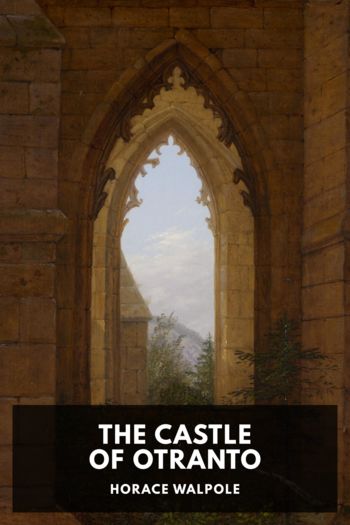The Castle of Otranto Horace Walpole (best free ereader .TXT) 📖

- Author: Horace Walpole
Book online «The Castle of Otranto Horace Walpole (best free ereader .TXT) 📖». Author Horace Walpole
By Horace Walpole.
This ebook is the product of many hours of hard work by volunteers for Standard Ebooks, and builds on the hard work of other literature lovers made possible by the public domain.
This particular ebook is based on a transcription produced for Project Gutenberg and on digital scans available at Google Books.
The writing and artwork within are believed to be in the U.S. public domain, and Standard Ebooks releases this ebook edition under the terms in the CC0 1.0 Universal Public Domain Dedication. For full license information, see the Uncopyright at the end of this ebook.
Standard Ebooks is a volunteer-driven project that produces ebook editions of public domain literature using modern typography, technology, and editorial standards, and distributes them free of cost. You can download this and other ebooks carefully produced for true book lovers at standardebooks.org.
Sonnet to the Right Honourable Lady Mary CokeThe gentle maid, whose hapless tale
These melancholy pages speak;
Say, gracious lady, shall she fail
To draw the tear adown thy cheek?
No; never was thy pitying breast
Insensible to human woes;
Tender, tho’ firm, it melts distrest
For weaknesses it never knows.
Oh! guard the marvels I relate
Of fell ambition scourg’d by fate,
From reason’s peevish blame.
Blest with thy smile, my dauntless sail
I dare expand to Fancy’s gale,
For sure thy smiles are Fame.
H. W.
IntroductionHorace Walpole was the youngest son of Sir Robert Walpole, the great statesman, who died Earl of Orford. He was born in 1717, the year in which his father resigned office, remaining in opposition for almost three years before his return to a long tenure of power. Horace Walpole was educated at Eton, where he formed a school friendship with Thomas Gray, who was but a few months older. In 1739 Gray was travelling-companion with Walpole in France and Italy until they differed and parted; but the friendship was afterwards renewed, and remained firm to the end. Horace Walpole went from Eton to King’s College, Cambridge, and entered Parliament in 1741, the year before his father’s final resignation and acceptance of an earldom. His way of life was made easy to him. As Usher of the Exchequer, Comptroller of the Pipe, and Clerk of the Estreats in the Exchequer, he received nearly two thousand a year for doing nothing, lived with his father, and amused himself.
Horace Walpole idled, and amused himself with the small life of the fashionable world to which he was proud of belonging, though he had a quick eye for its vanities. He had social wit, and liked to put it to small uses. But he was not an empty idler, and there were seasons when he could become a sharp judge of himself. “I am sensible,” he wrote to his most intimate friend, “I am sensible of having more follies and weaknesses and fewer real good qualities than most men. I sometimes reflect on this, though, I own, too seldom. I always want to begin acting like a man, and a sensible one, which I think I might be if I would.” He had deep home affections, and, under many polite affectations, plenty of good sense.
Horace Walpole’s father died in 1745. The eldest son, who succeeded to the earldom, died in 1751, and left a son, George, who was for a time insane, and lived until 1791. As George left no child, the title and estates passed to Horace Walpole, then seventy-four years old, and the only uncle who survived. Horace Walpole thus became Earl of Orford, during the last six years of his life. As to the title, he said that he felt himself being called names in his old age. He died unmarried, in the year 1797, at the age of eighty.
He had turned his house at Strawberry Hill, by the Thames, near Twickenham, into a Gothic villa—eighteenth-century Gothic—and amused himself by spending freely upon its adornment with such things as were then fashionable as objects of taste. But he delighted also in his flowers and his trellises of roses, and the quiet Thames. When confined by gout to his London house in Arlington Street, flowers from Strawberry Hill and a bird were necessary consolations. He set up also at Strawberry Hill a private printing press, at which he printed his friend Gray’s poems, also in 1758 his own Catalogue of the Royal and Noble Authors of England, and five volumes of Anecdotes of Painting in England, between 1762 and 1771.
Horace Walpole produced The Castle of Otranto in 1765, at the mature age of forty-eight. It was suggested by a dream from which he said he waked one morning, and of which “all I could recover was, that I had thought myself in an ancient castle (a very natural dream for a head like mine, filled with Gothic story), and that on the uppermost banister of a great staircase I saw a gigantic hand in armour. In the evening I sat down and began to write, without knowing in the least what I intended to say or relate.” So began the tale which professed to be translated by “William Marshal, gentleman, from the Italian of Onuphro Muralto, canon of the Church of St. Nicholas, at Otranto.” It was written in two months. Walpole’s friend Gray reported to him that at Cambridge the book made “some of them cry a little, and all in general afraid to go to bed o’ nights.” The Castle of Otranto was, in its own way, an early sign of the reaction towards romance in the latter part of the last century. This





Comments (0)